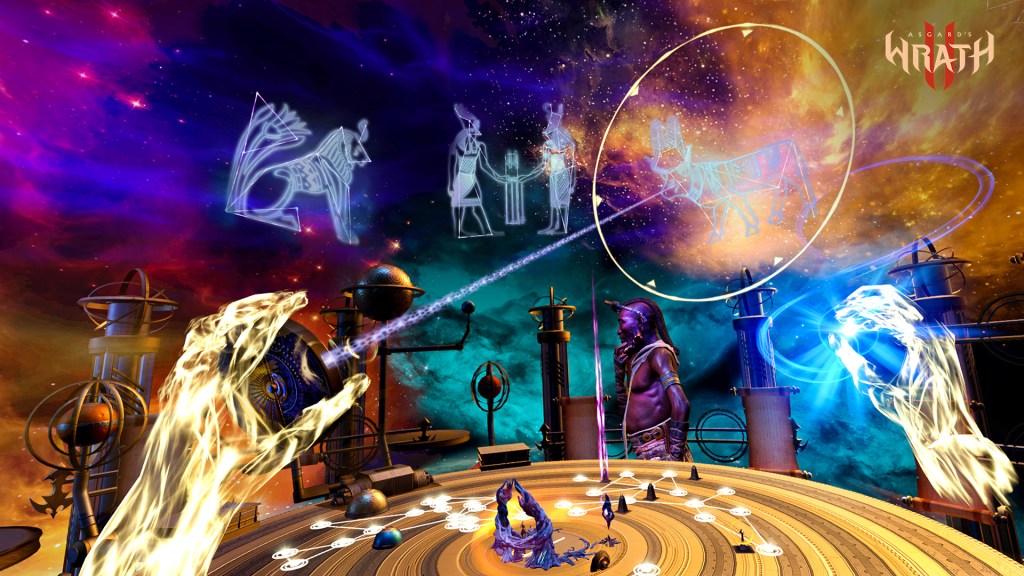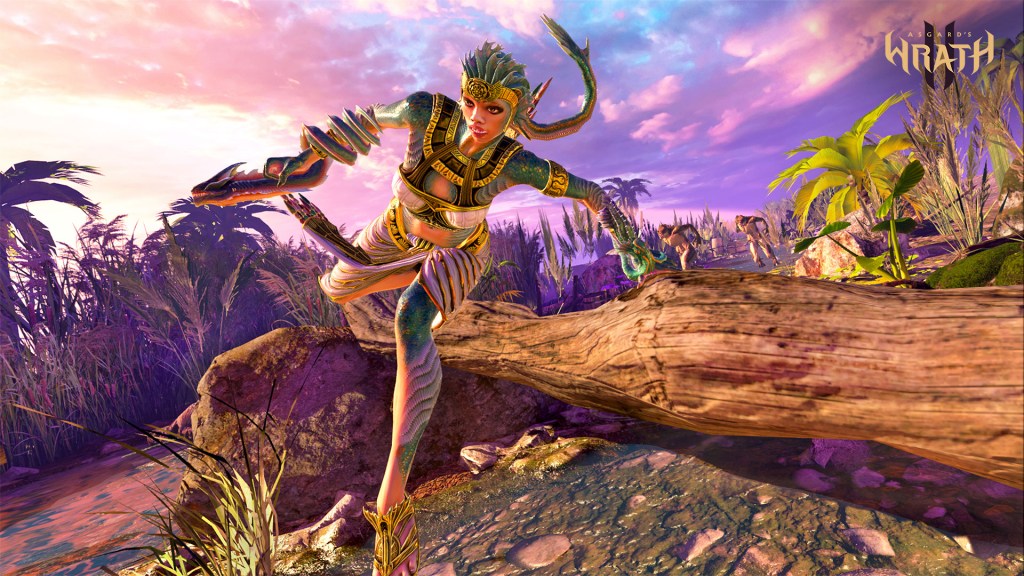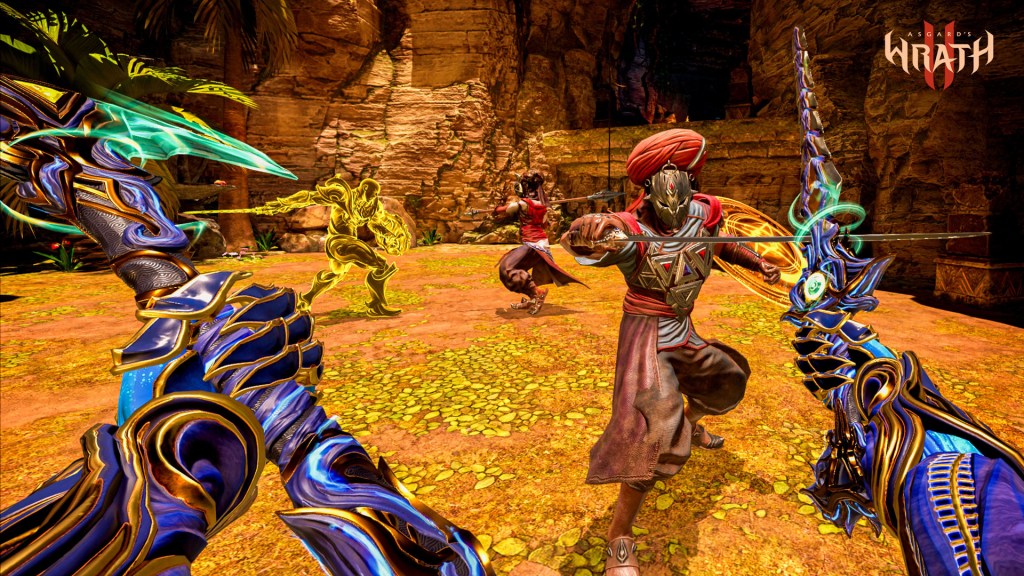![]()
It can feel like a lot of VR adventures can sort of chop an experience up into sections, not really feeling on par with a title you’d play on a console or PC. With Asgard’s Wrath 2, I felt like I was going through a definitive action-RPG that had these open world experiences and would feel as home on a PS5 or Switch as it does in VR on the Quest 3.
Asgard’s Wrath 2 picks up where the sequel left off. Betrayed by their “mentor” Loki, the player’s fledgling god is trapped. After a supernatural creature breaks into the otherworldly tavern where you’re locked away and a brief bout with it, the three Weavers pluck you out of danger and reveal that fledgling is really a Cosmic Guardian. Loki used the power gained in the first game to head to new realms, and now the player goes from Norse mythology to Egyptian mythology, working alongside Horus and his allies to face Set and new opponents. It’s a big game that sends you off through different worlds, with four heroes and five followers to rely on at your side.
I didn’t expect this sense of scale. Aegir's Hall and the Temple of Atum ease someone into the adventure. Explore one building. Go through rooms of a dungeon leading up to the exit. But once in Horus’ hideout and the more open world, it really felt like I was exploring any other action-RPG. While Horus’ home isn’t massive, you can look up and around to see the statues’ height, peek around corners on your way to speak to Bes, and are just in this larger space. But then in the open areas of the desert itself, it just feels like there are opportunities.

For example, not long after taking my first steps into the desert, I was following a trail of destruction while searching for my first follower. I saw one of the larger Apex Predator enemies that someone encounter. However, it wasn’t coming after me. Rather, it was attacking some of the humanoid minions of Set, wiping them out. It really helped set the scene as I watched from afar. (Later, when I’d get to face the Deathstalker and similar foes, it almost felt like okay, this is starting to feel like maybe how I’d want to approach a VR Monster Hunter game.) As I continued, I found off-the-beaten path areas with enemies three or four levels higher than I was, guarding treasure and in spaces that encouraged me to explore on my way to objectives. With that, it helped that other players may have left Dark Souls-like Cosmic Projections as a ghost “alert” to a point of interest.
Combat also is deeper than I expected. For example, your first hero Abraxas has a sword and a throwing axe, with the sword also being used for grappling in some situations and the axe for ranged attacks or hitting switches. Cyrene and Alvilda both have these ranged components, which mean you could use Cyrene’s harp or jellyfish to attack from a distance or hit multiple enemies, while Alvilda can shoot arrows with her bow, toss a mine. The different heroes’ movesets mean that you get to experiment with combat styles, then can prioritize ones you like when exploring or going into the Uncharted Rift roguelike dungeon in the Inbetween. It’s diverse, comfortable, and even feels like it’s good for accessibility considering the different melee, ranged, and control means for each type of moveset and weapon. Combine that with a skill tree for characters as they level up, the followers you can use as mounts to go around the world, and the skill trees for them, and it's all just very complex.
Even more so because these people can have some distinct personalities! When your Cosmic Guardian is riding shotgun in a hero's body, they'll banter and offer insight into the world with you. (Spoilers aside, Abraxas' initial conversations got me wondering about the differences between the Norse gods in Asgard's Wrath and Egyptian ones in Asgard's Wrath 2, as well as the relationships between the divine and mortals.) With your followers, it feels like they grow alongside you. I'd even say enemies become bigger "jerks" due to how they begin to learn and adapt to your go-to moves, unless you drop down to the easiest difficulty level that prioritizes the story.

The design of it also makes me feel like it’s skirting the line between accessible and showcasing VR game staples while doing so in an integrated way that doesn’t make them feel like a gimmick. Yes, there’s a fishing minigame, but you catches could be used as components when creating items or as a follower gift. You could go through minigames that involve using a slingshot to hit targets or sliding disks on a grid to land on certain spaces and appear on a leaderboard. Even the Uncharted Rifts roguelite dungeons can feel like a short combat experience more akin to other VR fantasy adventures focused on going through a few challenges and facing foes. The only time I felt like things were leaning into territories where it was a bit frustrating or unnecessary involved some context-sensitive actions for certain moves or actions. A good early example involved throwing Abraxas' axe, holding a trigger, then making a motion with your hand to alter its path to hit switches. Learning the proper and timing frustrated me a bit.
I also appreciate how it almost feels like Asgard’s Wrath 2 is breaking the fourth wall in its adventure. It acknowledges that when you’re using these human heroes, there are moments when you’ll hold Y to step back into your full, Cosmic Guardian god form. This larger being has a greater view of the world around them and can influence the environment in different ways, allowing for some really fun puzzles. Especially when they also involve realizing when to transfer your consciousness back into the hero you’re controlling for the next steps.
It also feels like it strives for the sort of interactions between characters that we’re seeing in games like God of War and Mass Effect. There is actually a relationship system with followers that allows you to become friends with them via interactions like gifts. Your characters gain new skills via a tree, and so do them. You have additional side quests you can take, though that could involve a fetch quest like grabbing some ingredients while you’re doing other things in the world. You’re able to go out of your way to hunt or fight these optional, stronger than usual enemies like Apex Predators, take those items to cook or craft equipment, and benefit from it.

